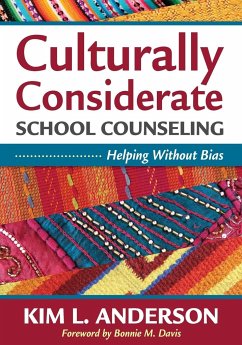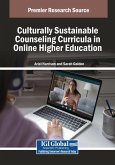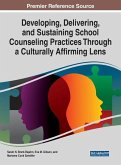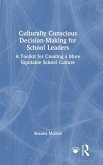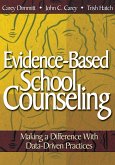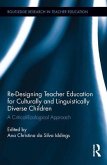Schade – dieser Artikel ist leider ausverkauft. Sobald wir wissen, ob und wann der Artikel wieder verfügbar ist, informieren wir Sie an dieser Stelle.
- Broschiertes Buch
- Merkliste
- Auf die Merkliste
- Bewerten Bewerten
- Teilen
- Produkt teilen
- Produkterinnerung
- Produkterinnerung
This compassionately written guidebook cultivates "cultural competence," integrates ASCA National Model standards, and provides strategies for exploring each student's individuality and responding accordingly.
Andere Kunden interessierten sich auch für
![Culturally Sustainable Counseling Curricula in Online Higher Education Culturally Sustainable Counseling Curricula in Online Higher Education]() Culturally Sustainable Counseling Curricula in Online Higher Education135,99 €
Culturally Sustainable Counseling Curricula in Online Higher Education135,99 €![Culturally Sustainable Counseling Curricula in Online Higher Education Culturally Sustainable Counseling Curricula in Online Higher Education]() Culturally Sustainable Counseling Curricula in Online Higher Education180,99 €
Culturally Sustainable Counseling Curricula in Online Higher Education180,99 €![Developing, Delivering, and Sustaining School Counseling Practices Through a Culturally Affirming Lens Developing, Delivering, and Sustaining School Counseling Practices Through a Culturally Affirming Lens]() Developing, Delivering, and Sustaining School Counseling Practices Through a Culturally Affirming Lens253,99 €
Developing, Delivering, and Sustaining School Counseling Practices Through a Culturally Affirming Lens253,99 €![Building Culturally Responsive Classrooms Building Culturally Responsive Classrooms]() Concha Delgado GaitanBuilding Culturally Responsive Classrooms85,99 €
Concha Delgado GaitanBuilding Culturally Responsive Classrooms85,99 €![Culturally Conscious Decision-Making for School Leaders Culturally Conscious Decision-Making for School Leaders]() Shauna McGeeCulturally Conscious Decision-Making for School Leaders206,99 €
Shauna McGeeCulturally Conscious Decision-Making for School Leaders206,99 €![Evidence-Based School Counseling Evidence-Based School Counseling]() Carey Dimmitt / John C. Carey / Trish HatchEvidence-Based School Counseling42,99 €
Carey Dimmitt / John C. Carey / Trish HatchEvidence-Based School Counseling42,99 €![Re-Designing Teacher Education for Culturally and Linguistically Diverse Students Re-Designing Teacher Education for Culturally and Linguistically Diverse Students]() Re-Designing Teacher Education for Culturally and Linguistically Diverse Students242,99 €
Re-Designing Teacher Education for Culturally and Linguistically Diverse Students242,99 €
This compassionately written guidebook cultivates "cultural competence," integrates ASCA National Model standards, and provides strategies for exploring each student's individuality and responding accordingly.
Produktdetails
- Produktdetails
- Verlag: Corwin
- Seitenzahl: 192
- Erscheinungstermin: 7. September 2010
- Englisch
- Abmessung: 254mm x 178mm x 11mm
- Gewicht: 373g
- ISBN-13: 9781412987516
- ISBN-10: 1412987512
- Artikelnr.: 30412946
- Herstellerkennzeichnung
- Libri GmbH
- Europaallee 1
- 36244 Bad Hersfeld
- gpsr@libri.de
- Verlag: Corwin
- Seitenzahl: 192
- Erscheinungstermin: 7. September 2010
- Englisch
- Abmessung: 254mm x 178mm x 11mm
- Gewicht: 373g
- ISBN-13: 9781412987516
- ISBN-10: 1412987512
- Artikelnr.: 30412946
- Herstellerkennzeichnung
- Libri GmbH
- Europaallee 1
- 36244 Bad Hersfeld
- gpsr@libri.de
Kim L. Anderson's career path has been a diverse and divergent one. Prior to obtaining a graduate degree in social work from Washington University in St. Louis, she was a freelance writer, photographer and graphic artist with interests in "outsider art," expressions of oppression and liberation beyond conventional artistic borders or boundaries. After many years of private practice as a licensed clinical social worker, clinical supervisor and educator, Kim received a post-graduate certificate in art psychotherapy and now is a board certified art therapist. She is the author of Culturally Considerate School Counseling: Helping Without Bias, published by Corwin Press in 2010. Ms. Anderson presents her eclectic work at numerous local, regional and national events and venues, engaging her audience through compelling narrative, careful research, evocative experiences, and instructive storytelling. Read Kim Anderson¿s blogpost: http://niusileadscape.org/bl/ and follow her on Twitter @kandersonlcsw!
Foreword by Bonnie M. Davis, PhD
Preface
Acknowledgments
About the Author
Part I. Populations to Consider
1. Culturally Considerate Counseling
2. Religion and Spirituality
3. Different Abilities
4. Aesthetic Issues
5. Illness
6. Environmental Issues
7. Gender and Sexuality Issues
Part II. Interfacing With Family, Faculty, Administration, and Community
8. School-Family-Community Partnerships
9. Team Building
Part III. School Counseling in the Age of Change
10. Consider These Counseling Challenges
Part IV. School Counselors as Change Agents: Opportunities for Growth
11. Expanding Clinical Skills
12. Self-Care for the Caregiver
Afterword: What Is a School Without Bias?
Resources
References
Index
Preface
Acknowledgments
About the Author
Part I. Populations to Consider
1. Culturally Considerate Counseling
2. Religion and Spirituality
3. Different Abilities
4. Aesthetic Issues
5. Illness
6. Environmental Issues
7. Gender and Sexuality Issues
Part II. Interfacing With Family, Faculty, Administration, and Community
8. School-Family-Community Partnerships
9. Team Building
Part III. School Counseling in the Age of Change
10. Consider These Counseling Challenges
Part IV. School Counselors as Change Agents: Opportunities for Growth
11. Expanding Clinical Skills
12. Self-Care for the Caregiver
Afterword: What Is a School Without Bias?
Resources
References
Index
Foreword by Bonnie M. Davis, PhD
Preface
Acknowledgments
About the Author
Part I. Populations to Consider
1. Culturally Considerate Counseling
2. Religion and Spirituality
3. Different Abilities
4. Aesthetic Issues
5. Illness
6. Environmental Issues
7. Gender and Sexuality Issues
Part II. Interfacing With Family, Faculty, Administration, and Community
8. School-Family-Community Partnerships
9. Team Building
Part III. School Counseling in the Age of Change
10. Consider These Counseling Challenges
Part IV. School Counselors as Change Agents: Opportunities for Growth
11. Expanding Clinical Skills
12. Self-Care for the Caregiver
Afterword: What Is a School Without Bias?
Resources
References
Index
Preface
Acknowledgments
About the Author
Part I. Populations to Consider
1. Culturally Considerate Counseling
2. Religion and Spirituality
3. Different Abilities
4. Aesthetic Issues
5. Illness
6. Environmental Issues
7. Gender and Sexuality Issues
Part II. Interfacing With Family, Faculty, Administration, and Community
8. School-Family-Community Partnerships
9. Team Building
Part III. School Counseling in the Age of Change
10. Consider These Counseling Challenges
Part IV. School Counselors as Change Agents: Opportunities for Growth
11. Expanding Clinical Skills
12. Self-Care for the Caregiver
Afterword: What Is a School Without Bias?
Resources
References
Index

